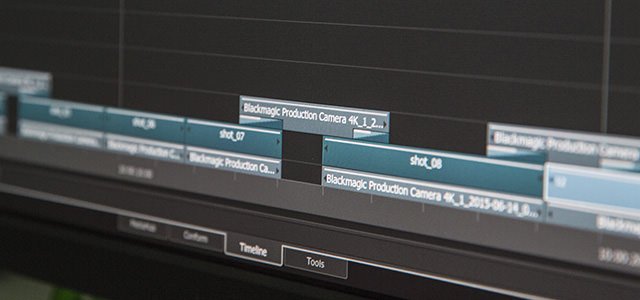Post production is the final step in the process of filmmaking. Nowadays it’s mostly a digital process. Nevertheless, the amount and degree of post-production can vary a lot depending on the project. That’s the reason why we employ individual workflows for our clients’ projects, to work efficiently and successfully within the agreed deadlines and budgets.
We use a variety of different operating systems (Windows, OS X and Linux) and software (for editing for example: Adobe CC Suite, Avid Media Composer, Final Cut). This allows us to take over existing projects and continue working on them from any stage. Our workstations are equipped for editing HD, 4k and 360 degree footage.

Digital post production consists of five steps:
I. Ingest and Editing
The postproduction of every digital video project starts with importing the data into the appropriate software. Depending on the software, incoming formats and direction of post-production, it’s often necessary to convert the data into a designated format. After that the editing begins and all scenes are put in order.
II. Visual Effects and Compositing
Visual effects usually take place when the editing process is finished. Visual effects are sometimes very time-consuming and complex. Because of that applying them to scenes which won’t be in the final film should be avoided. The process of combining visual effects with the recorded material is called compositing. Typical visual effects that are often used, even in smaller productions, are Greenscreen Chroma-Keying, motion graphics, video retouch and deleting of image content.
III. Colour Correction and Colour Grading
Applying a “look” to a video can generate or enhance the atmosphere in a fictional scene. This process is called colour grading. In a similar way, documentary films that usually aim at a more naturalistic look also benefit from a well-aimed colour correction. Processing the colours is the last step in filmmaking, as far as the image is concerned.
IV. Sound Design and Sound Mixing
Viewers rarely notice good sound quality – what they do notice however is bad quality. That’s why every film needs a special audio treatment, in accordance with the planned output format (online, tv or cinema). It’s important to consider the defined technical audio norms and regulations.
For TV and cinema these regulations are particularly precise and restrictive. Non-compliance would in the worst case cause the film to be rejected by the television station or cinema in question.
V. Finalisation and Export
When everything is done on the aesthetic it’s time for the finalisation or finishing. All picture and sound elements that have been edited in different programs are put together and prepared for export. Now we can export all digital formats as needed. This may be files for online publishing, Blu Rays, DVDs or DCPs (Digital Cinema Package for screening in theatres).

Example for a fully produced still made for the Deutsche Welle
Our Experience in Post-Production
We offer our specialised services in post-production to an ever-growing number of partners and production companies. We do online and offline editing, visual effects, motion graphics and compositing. Whether it’s a short project for web or television, a feature length documentary or a whole series of videos – we’ve done it before and we’ll do it again.
Our customers value our versatility and flexibility, while at the same time strictly adhering to time specifications, formats and budgets. Feel free to get in touch to discuss what we can do for you.

















